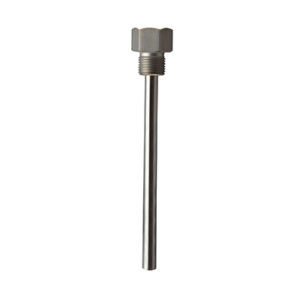
Quick guide: Thermowells
- October 22, 2019
- , 7:25 am
- , Blog
When a process is tough on your instrumentation, a thermowell might be a great option to protect the instrument from abrasion or corrosion. Thermowells are simple on the basis, but there are some variations possible which we will explain today.
Let’s start with the basics: What is a thermowell?
What is a thermowell? A thermowell is, in essence, a metal pipe that encases the part of an instrument that is to be inserted into the process. By providing a barrier between the instrument and the process, the thermowell reduces wear on the instrument. This is because the instrument is no longer in contact with the process. Depending on the medium that the thermowell is protecting the instrument from, this also means that corrosion or abrasion from heavy media is inflicted on the thermowell rather than the instrument.
Now that you understand in it’s most simple explanation what a thermowell is, let us look into some more of the features of using them:
Let’s start with the basics: What is a thermowell?
You don’t have to interrupt the process when you have to replace one broken instrument, the thermowell will ensure that the process can keep running. That makes a thermowell among the simplest yet least well-publicized accessories used in industrial temperature measurement applications. The new instrument can simply be inserted into the thermowell and that’s that!
A more secure process connection.
When an instrument is connected directly to the process, the option of permanently attaching the instrument to the process is not an option, because it has to be replaced when it’s broken. With a weld-in thermowell you can weld the connection, ensuring a perfect seal.
A more secure process connection.
Thermowells have a lot of customizability. When selecting a thermowell one should always look for the best option for their process.
Thermowells are produced in two different fashions: Welded or Machined. As the name suggests, welded thermowells are welded constructions and machined thermowells are machined out of solid metal. Machined thermowells are better suited for high-pressure applications, while a welded construction has more than enough strength for low to average pressure applications.
The most common material for thermowells is stainless steel due to the high corrosion resistance and rigid nature. Stainless steel is also an inert material, meaning is does not react with most chemical compounds, leaving no traces, tastes or smells in the medium.
There are several connection options, the most common are:
- Fixed thread connection
- Sliding thread connection
- Weld-in connection (plain)
Combining this with any inside/outside diameter and any length possible, the options seem limitless
Things to consider:
- The maximum length of a thermowell can be around 5 to 6 meters. This has to do with the maximum size steel pipe or bar is produced in.
- Thermowells are suitable for high temperatures up to 900°C in air. However, this is not advised. Maximum operational temperatures should be around 600°C.
- Thicker walled thermowells have a longer lifetime, but they can lower response time. This can be counteracted by choosing a tightly fitting insert diameter or by using a heat conductor like thermal paste to increase response times.
With this brief guide on thermowells, we hope it has become clearer to you what they are and why anyone should use them. There is, of course, a lot more to learn about thermowells, such as using different shapes and materials for different processes. We will come back to this subject in a later blog.
Is there a specific question you want to ask about thermowells? Let us know by sending us an email at info@tuvo-instruments.com and we will answer you as soon as possible!
